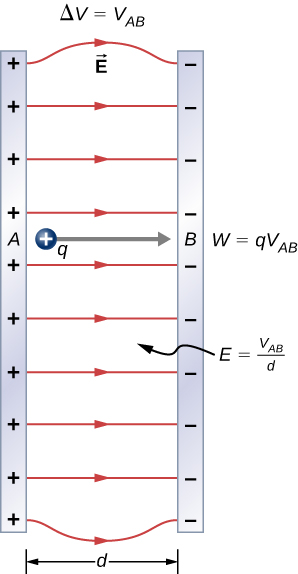| << Chapter < Page | Chapter >> Page > |
From our previous discussion of the potential energy of a charge in an electric field, the result is independent of the path chosen, and hence we can pick the integral path that is most convenient.
Consider the special case of a positive point charge q at the origin. To calculate the potential caused by q at a distance r from the origin relative to a reference of 0 at infinity (recall that we did the same for potential energy), let and with and use When we evaluate the integral
for this system, we have
which simplifies to
This result,
is the standard form of the potential of a point charge. This will be explored further in the next section.
To examine another interesting special case, suppose a uniform electric field is produced by placing a potential difference (or voltage) across two parallel metal plates, labeled A and B ( [link] ). Examining this situation will tell us what voltage is needed to produce a certain electric field strength. It will also reveal a more fundamental relationship between electric potential and electric field.

From a physicist’s point of view, either or can be used to describe any interaction between charges. However, is a scalar quantity and has no direction, whereas is a vector quantity, having both magnitude and direction. (Note that the magnitude of the electric field, a scalar quantity, is represented by E .) The relationship between and is revealed by calculating the work done by the electric force in moving a charge from point A to point B . But, as noted earlier, arbitrary charge distributions require calculus. We therefore look at a uniform electric field as an interesting special case.
The work done by the electric field in [link] to move a positive charge q from A , the positive plate, higher potential, to B , the negative plate, lower potential, is
The potential difference between points A and B is
Entering this into the expression for work yields
Work is ; here , since the path is parallel to the field. Thus, . Since , we see that .
Substituting this expression for work into the previous equation gives
The charge cancels, so we obtain for the voltage between points A and B
where d is the distance from A to B , or the distance between the plates in [link] . Note that this equation implies that the units for electric field are volts per meter. We already know the units for electric field are newtons per coulomb; thus, the following relation among units is valid:
Furthermore, we may extend this to the integral form. Substituting [link] into our definition for the potential difference between points A and B , we obtain

Notification Switch
Would you like to follow the 'University physics volume 2' conversation and receive update notifications?